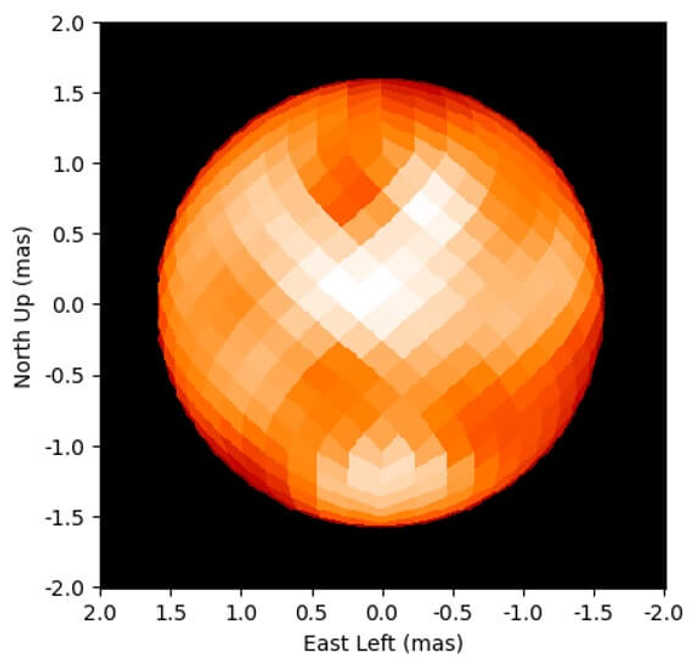Published 20:44 IST, August 22nd 2024
Stunning First-Ever Images of the North Star’s Surface Captured By Scientists
CHARA Array's high-resolution images reveal new details about Polaris, including surface spots and its triple-star system, enhancing understanding.
“Star of the north! whose steadfast ray Pierces the sable pall of night,
Forever pointing out the way That leads to freedom's hallowed light”
This is a poem titled “The North Star,” written by James Monroe Whitfield in the mid-19th century. The Polaris, also known as the North Star is not something only related to the scientists only, but it also has a deep connection with the humam race living on the blue planet for years.
In our solar system, scattered across one of Earth's verdant mountains, six eggshell-white telescopes gaze into the deep universe. As one cohesive unit, the domed structures collect cosmic light to guide modern astronomers exploring space. Thanks to this array, we now have a brilliant new perspective on the light that guided astronomers of the past: the North Star.
For decades, Earth's inhabitants have looked at a certain point in the sky to know their direction, to understand where they are coming from, and to determine where they need to go. But now, we finally have high-resolution images of the North Star’s surface.

Historical Depictions and Scientific Advances
Before reaching this point, there were many depictions of the North Star created by the human race. Artists of all eras portrayed a shiny object in the sky as the North Star, and painters depicted what they could see with their bare eyes, brushing it onto their canvases. Scientists directed their telescopes towards the North to gather what they could. After years of research and waiting, scientists have received the first high-resolution images of the Pole Star. But what makes these images so special that they have covered the whole internet?
CHARA Array and Its Contributions
The telescopes of the CHARA Array, situated on Mount Wilson in California, work in tandem with one another. The data from these telescopes is combined in a central facility to provide one cohesive and clear picture of the source. The sextet of working telescopes effectively creates one ultimate telescope with a diameter of 330 meters (about 1083 feet). This configuration provides excellent image resolution, particularly its angular resolution.
New Discoveries about Polaris
After reviewing Polaris images combined with CHARA observations from 2016 to 2021, scientists have uncovered new features of the star. Most notably, they’ve discovered visible spots on Polaris’s surface, similar to the sunspots we occasionally observe on the Sun.
"The CHARA images revealed large bright and dark spots on the surface of Polaris that changed over time," Gail Schaefer, director of the CHARA Array, said in a statement.

This discovery was surprising primarily because Polaris is not an ordinary star. It's a Cepheid variable star, known for its periodic brightening and dimming. Specifically, Polaris fluctuates in brightness on a four-day cycle, making it valuable for cosmic distance measurements due to this predictable behavior. By observing the changes in a Cepheid’s brightness over its cycle, scientists can determine its true brightness.
Significance and Future Research
In contrast, without predictable pulsations, a star's dimness might be due to distance, size, or other factors, making it unreliable for such measurements.
The CHARA team’s high-resolution images provided the first "glimpse of what the surface of a Cepheid variable looks like," revealing these intriguing spots. But this wasn’t the only finding from their analysis.
Unlike our solitary Sun, Polaris is part of a triple-star system, about 46 times the size of our Sun and located over 400 light-years away. It’s the brightest of the trio. The initial goal of CHARA's investigation was to map the orbit of the star that orbits Polaris every 30 years, a complex task given the star’s close proximity and faintness. The companion star, confirmed only around 2005 by the Hubble Space Telescope, is difficult to resolve due to the small separation and significant brightness contrast.
"The small separation and large contrast in brightness between the two stars make it extremely challenging to resolve the binary system during their closest approach," said team lead Nancy Evans at the Center for Astrophysics, Harvard & Smithsonian, who also contributed to the companion's identification. To tackle this, the team also utilized other astronomical tools, including a speckle interferometer at the Apache Point Observatory in New Mexico.
The mission successfully confirmed Polaris’s size and suggested it might be about five times more massive than the Sun, which is more than previously estimated. This finding is significant because only a few Cepheids have had their masses determined, raising interesting questions for future exploration. "The mass combined with the distance shows that the Cepheid is more luminous than predicted for this mass from evolutionary tracks," the study authors write.
Future Exploration
However, the North Star’s spotted surface has captured the most attention. The spots and the star’s rotation suggest a 120-day radial velocity variation, indicating changes in velocity along an observer's line of sight, which poses another puzzle.
"We plan to continue imaging Polaris in the future," John Monnier, an astronomy professor at the University of Michigan and co-author of the study, said in a statement. "We hope to better understand the mechanism that generates the spots on the surface of Polaris."
Updated 15:51 IST, August 23rd 2024